Thunderbolt 3 in Action: Akitio Thunder3 Duo Pro DAS Review
by Ganesh T S on April 14, 2016 8:30 AM EST- Posted in
- Storage
- DAS
- Thunderbolt 3
- Akitio
Direct-Attached Storage Performance
Given the presence of two bays, it is clear that the system needs to be fitted with SSDs in order to deliver maximum performance. We chose two Intel DC S3510 240GB SSDs as the members of a RAID-0 array for benchmarking purposes. Prior to taking a look at the real-life benchmarks, we first check what ATTO and CrystalDiskMark have to report.
ATTO shows performance numbers close to 800 MBps for large-sized reads, and it is backed up somewhat by CrystalDiskMark also.
In order to tackle the first real-life use-case, we created three test folders with the following characteristics:
- Photos: 15.6 GB collection of 4320 photos (RAW as well as JPEGs) in 61 sub-folders
- Videos: 16.1 GB collection of 244 videos (MP4 as well as MOVs) in 6 sub-folders
- BR: 10.7 GB Blu-ray folder structure of the IDT Benchmark Blu-ray (the same that we use in our robocopy tests for NAS systems)
| Akitio Thunder3 Duo Pro + 2x Intel SSD DC S3510 (Thunderbolt 3) robocopy Benchmarks (MBps) |
||
| Write Bandwidth | Read Bandwidth | |
| Photos | 526.00 | 398.80 |
| Videos | 522.75 | 538.06 |
| Blu-ray Folder | 525.68 | 568.55 |
The above benchmark run was also instrumented to record the temperature of one of the SSDs as well as the instantaneous transfer rate to the DAS unit during the process. The internal disk temperature never exceeded 38 C even after more than 127 GB of writes and 127 GB of reads continuously.
For the second use-case, we take advantage of PC Mark 8's storage bench. The storage workload involves games as well as multimedia editing applications. The command line version allows us to cherry-pick storage traces to run on a target drive. We chose the following traces.
- Adobe Photoshop (Light)
- Adobe Photoshop (Heavy)
- Adobe After Effects
- Adobe Illustrator
Usually, PC Mark 8 reports time to complete the trace, but the detailed log report has the read and write bandwidth figures which we present in our performance graphs. Note that the bandwidth number reported in the results don't involve idle time compression. Results might appear low, but that is part of the workload characteristic. This is not the intended use-case for portable hard drives, but the results are just presented here for the sake of completeness
| Akitio Thunder3 Duo Pro + 2x Intel SSD DC S3510 (Thunderbolt 3) PCMark8 Storage Benchmarks (MBps) |
||
| Write Bandwidth | Read Bandwidth | |
| Adobe Photoshop (Light) | 612.44 | 167.14 |
| Adobe Photoshop (Heavy) | 578.53 | 225.74 |
| Adobe After Effects | 265.09 | 227.90 |
| Adobe Illustrator | 488.68 | 217.72 |
While the above numbers are very good, and what one expects from two SSDs in RAID-0, they do not bring out the real capabilities of Thunderbolt 3. For that purpose, we need to daisy chain multiple units.
Prior to looking at the daisy chaining results, let us see how the unit performs when fitted out with a couple of high-capacity hard disks in RAID-0. This is probably the configuration that most users would choose when looking for large amounts of fast and affordable storage. Two 8TB Seagate Enterprise NAS HDDs were installed in one of the units and all benchmarks that were run for the SSD configuration were repeated.
Note that the HDD configuration provides lower bandwidth, but much higher consistency. There is also not much benefit to higher queue depths in this configuration. The consistency aspect is also brought out in the performance consistency test.
| Akitio Thunder3 Duo Pro + 2x 8TB Seagate Enterprise NAS HDDs (Thunderbolt 3) robocopy Benchmarks (MBps) |
||
| Write Bandwidth | Read Bandwidth | |
| Photos | 346.22 | 301.99 |
| Videos | 376.31 | 348.88 |
| Blu-ray Folder | 372.49 | 375.63 |
| Akitio Thunder3 Duo Pro + 2x 8TB Seagate Enterprise NAS HDDs (Thunderbolt 3) PCMark8 Storage Benchmarks (MBps) |
||
| Write Bandwidth | Read Bandwidth | |
| Adobe Photoshop (Light) | 316.60 | 9.93 |
| Adobe Photoshop (Heavy) | 292.50 | 12.45 |
| Adobe After Effects | 71.11 | 9.58 |
| Adobe Illustrator | 204.77 | 9.06 |
We now move on to the results from our daisy-chaining experiments.


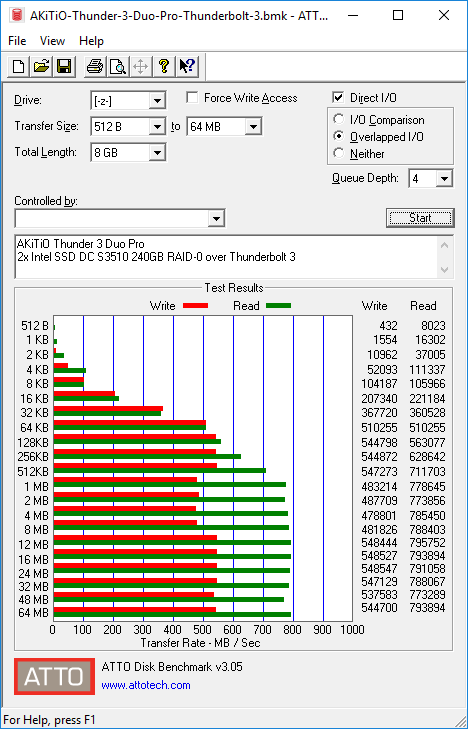
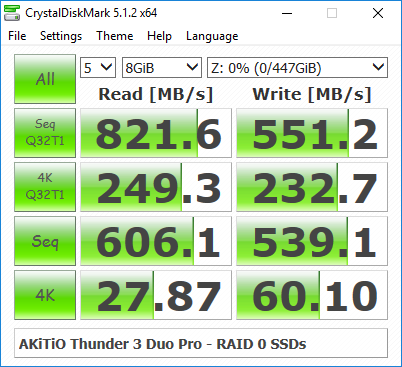

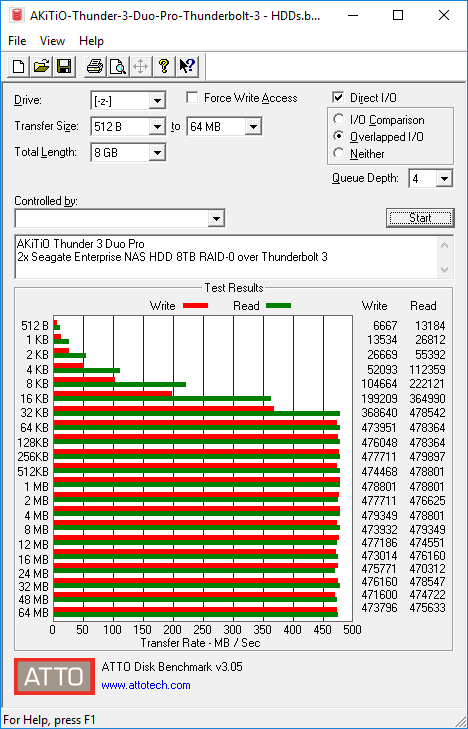
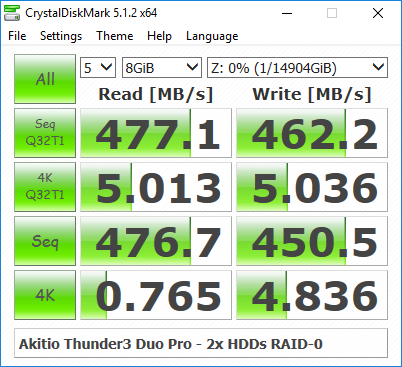
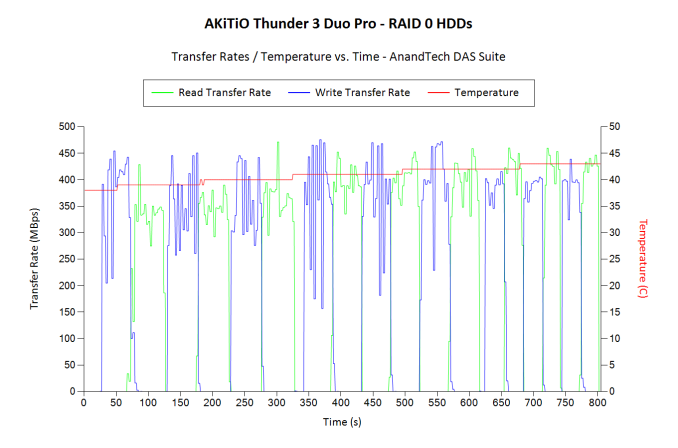








60 Comments
View All Comments
name99 - Thursday, April 14, 2016 - link
There is obviously a market for this sort of thing for SOME people, but if you're trying to save money, the way you do it is to use standard (high-performance) USB-3 cases and software RAID-1; there's no need to do that in the case.OSX and Linux obviously support RAID out of the box; I've no idea about Windows but I'd assume they're also on board. The only reason I can see that you need this hidden behind HW is if you need to move the device between different OS's.
danbob999 - Friday, April 15, 2016 - link
well there is this one for $50:http://www.newegg.com/Product/Product.aspx?Item=9S...
if you don't need a real case there are various dual dock for about $30. I also found dual 2.5" USB3 cases for $25.
Great_Scott - Thursday, April 14, 2016 - link
At $100 over the price of a normal enclosure, no one that really needs the extra features this offers will care. Thus the item will stay niche and the price will stay high.This is self-reinforcing problem.
TB is putting up a good fight, but the future doesn't look bright. No interface has ever survived higher prices by having better features. See: Microchannel, Token Ring, EISA, ATM, e-SATA and, yes, FireWire.
epobirs - Saturday, April 16, 2016 - link
Look at the Cineraid portable models. I picked up one from Newegg a couple of years ago for about $20 because the things weren't selling. Either the target market didn't know they existed or just didn't see the value. Mine still sits unpopulated because I don't have any great need for a somewhat faster USB 3.0 drive, unless I'm getting the drives really cheap. At the time I bought the unit I was getting a lot of requests for laptop SSD upgrades. The customers would either get their original hard put in an enclosure or just let me keep it for a token amount. (I'd label it and put it in a drawer for a month or so, in case the SSD proved defective.)I expected I'd have a couple of drives to use or sell it to somebody converting two laptops but neither situation came along since obtaining the Cineraid.
HideOut - Thursday, April 14, 2016 - link
The good news for us is that you will be asleep until hell freezes over. No more trolling from you.danbob999 - Thursday, April 14, 2016 - link
At $378 I might as well buy a PC... which will be able to hold at least 4 drives.jbrizz - Thursday, April 14, 2016 - link
People are going to plug these things into their Mac Pro, then do some 4k video editing on their 5k screen. You are not it's target audience (although you still shouldn't be so ignorant as to think that just because you don't want/need it no one else will).danbob999 - Thursday, April 14, 2016 - link
That's just one more reason why a Mac Pro is a crap PC. Such a professional PC should include room for at least 4 hard drives. Requiring an external $378 case just to get close to the same performance that you would get with internal drives is a joke.apoctwist - Friday, April 15, 2016 - link
I had to log into the site for the first time because of how silly this comment is. People working in the pro audio/pro video side are not going to rely on internal storage for their work or software RAID. First of all what happens when the machine you are using dies? What happens with your software RAID array on all those internal drives? With this device due to hardware RAID I can just plug in a cable on a new machine and I'm up and running in minutes. I don't have to worry about taking hard drives out of the PC, I don't have to worry about rebuilding the array (if that's even possible since you are using software RAID tied to you OS). All I have to worry about is a cable.That's why devices like these exist. In Pro video workflows external RAID arrays are common and encouraged. You see less heartache in the long run that way.
As an audio professional I have all of my projects/audio/recording on an external TB raid array. if my machine dies tomorrow I can pick up where I left off the next day. I also have multiple machines for DAW work and I can just plug my TB cable to them and continue working on whatever project I need to with no worries.
You are looking at a device like this from a consumer level but that's not what it's made for and the price tag is rather in line with what you will find out there for a TB enclosure.
theduckofdeath - Saturday, April 16, 2016 - link
It might sound like harsh words, but, he is right. At the moment,. everything Mac related is stupid solutions to problems we didn't have. Thunderbolt has to die. It's a way to milk consumers for even more money on relatively limited sales.There are a ton of ways to make a better solution for your external storage you actually need. The first choice is exactly what he said, design the workstation case to allow for stortage expansion, instead of selling people an overpriced and under-powered garbage bin.
There's a reason why companies like Oculus and HTC Vice refuse to support Mac OS these days. Because Mac devices are designed to work against the consumer from the foundation, Thunderbolt being one of the key culprits.